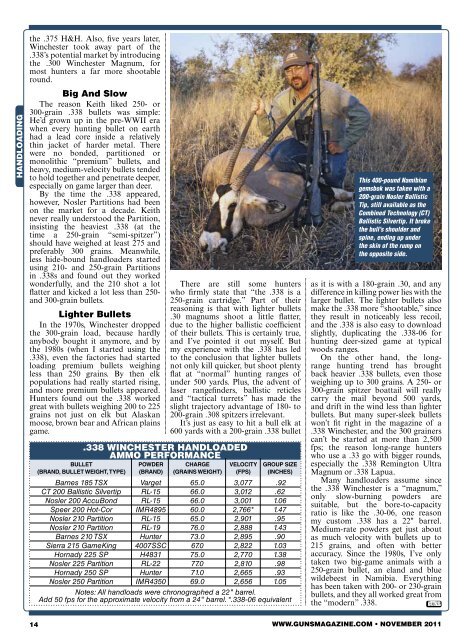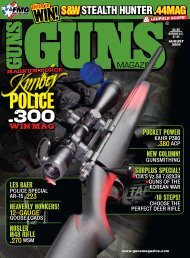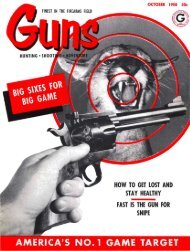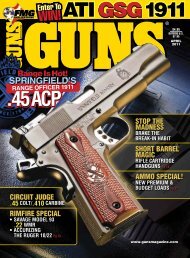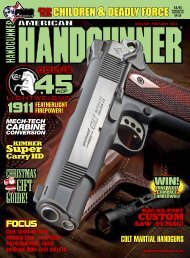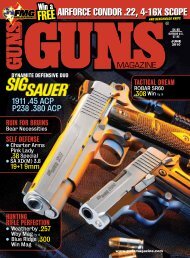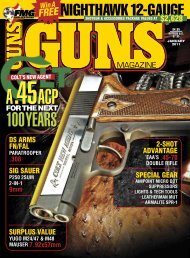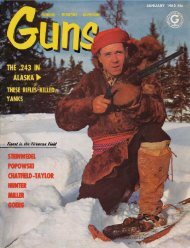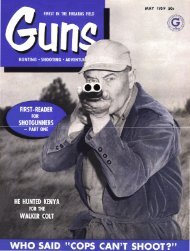Guns 2011-11.pdf - Jeffersonian
Guns 2011-11.pdf - Jeffersonian
Guns 2011-11.pdf - Jeffersonian
- No tags were found...
Create successful ePaper yourself
Turn your PDF publications into a flip-book with our unique Google optimized e-Paper software.
HANDLOADINGthe .375 H&H. Also, five years later,Winchester took away part of the.338’s potential market by introducingthe .300 Winchester Magnum, formost hunters a far more shootableround.Big And SlowThe reason Keith liked 250- or300-grain .338 bullets was simple:He’d grown up in the pre-WWII erawhen every hunting bullet on earthhad a lead core inside a relativelythin jacket of harder metal. Therewere no bonded, partitioned ormonolithic “premium” bullets, andheavy, medium-velocity bullets tendedto hold together and penetrate deeper,especially on game larger than deer.By the time the .338 appeared,however, Nosler Partitions had beenon the market for a decade. Keithnever really understood the Partition,insisting the heaviest .338 (at thetime a 250-grain “semi-spitzer”)should have weighed at least 275 andpreferably 300 grains. Meanwhile,less hide-bound handloaders startedusing 210- and 250-grain Partitionsin .338s and found out they workedwonderfully, and the 210 shot a lotflatter and kicked a lot less than 250-and 300-grain bullets.Lighter BulletsIn the 1970s, Winchester droppedthe 300-grain load, because hardlyanybody bought it anymore, and bythe 1980s (when I started using the.338), even the factories had startedloading premium bullets weighingless than 250 grains. By then elkpopulations had really started rising,and more premium bullets appeared.Hunters found out the .338 workedgreat with bullets weighing 200 to 225grains not just on elk but Alaskanmoose, brown bear and African plainsgame.There are still some hunterswho firmly state that “the .338 is a250-grain cartridge.” Part of theirreasoning is that with lighter bullets.30 magnums shoot a little flatter,due to the higher ballistic coefficientof their bullets. This is certainly true,and I’ve pointed it out myself. Butmy experience with the .338 has ledto the conclusion that lighter bulletsnot only kill quicker, but shoot plentyflat at “normal” hunting ranges ofunder 500 yards. Plus, the advent oflaser rangefinders, ballistic reticlesand “tactical turrets” has made theslight trajectory advantage of 180- to200-grain .308 spitzers irrelevant.It’s just as easy to hit a bull elk at600 yards with a 200-grain .338 bullet.338 Winchester HandloadedAmmo PerformanceBullet Powder Charge Velocity Group Size(brand, bullet weight, type) (brand) (grains weight) (fps) (inches)Barnes 185 TSX Varget 65.0 3,077 .92CT 200 Ballistic Silvertip RL-15 66.0 3,012 .62Nosler 200 AccuBond RL-15 66.0 3,001 1.06Speer 200 Hot-Cor IMR4895 60.0 2,766* 1.47Nosler 210 Partition RL-15 65.0 2,901 .95Nosler 210 Partition RL-19 76.0 2,888 1.43Barnes 210 TSX Hunter 73.0 2,895 .90Sierra 215 GameKing 4007SSC 67.0 2,822 1.03Hornady 225 SP H4831 75.0 2,770 1.38Nosler 225 Partition RL-22 77.0 2,810 .98Hornady 250 SP Hunter 71.0 2,665 .93Nosler 250 Partition IMR4350 69.0 2,656 1.05Notes: All handloads were chronographed a 22" barrel.Add 50 fps for the approximate velocity from a 24" barrel. *.338-06 equivalentThis 400-pound Namibiangemsbok was taken with a200-grain Nosler BallisticTip, still available as theCombined Technology (CT)Ballistic Silvertip. It brokethe bull’s shoulder andspine, ending up underthe skin of the rump onthe opposite side.as it is with a 180-grain .30, and anydifference in killing power lies with thelarger bullet. The lighter bullets alsomake the .338 more “shootable,” sincethey result in noticeably less recoil,and the .338 is also easy to downloadslightly, duplicating the .338-06 forhunting deer-sized game at typicalwoods ranges.On the other hand, the longrangehunting trend has broughtback heavier .338 bullets, even thoseweighing up to 300 grains. A 250- or300-grain spitzer boattail will reallycarry the mail beyond 500 yards,and drift in the wind less than lighterbullets. But many super-sleek bulletswon’t fit right in the magazine of a.338 Winchester, and the 300 grainerscan’t be started at more than 2,500fps; the reason long-range hunterswho use a .33 go with bigger rounds,especially the .338 Remington UltraMagnum or .338 Lapua.Many handloaders assume sincethe .338 Winchester is a “magnum,”only slow-burning powders aresuitable, but the bore-to-capacityratio is like the .30-06, one reasonmy custom .338 has a 22" barrel.Medium-rate powders get just aboutas much velocity with bullets up to215 grains, and often with betteraccuracy. Since the 1980s, I’ve onlytaken two big-game animals with a250-grain bullet, an eland and bluewildebeest in Namibia. Everythinghas been taken with 200- or 230-grainbullets, and they all worked great fromthe “modern” .338.14WWW.GUNSMAGAZINE.COM • NOVEMBER <strong>2011</strong>


